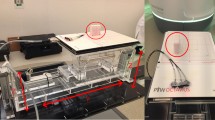Abstract
Purpose
To analyze the factors affecting the tracking accuracy of the CyberKnife Synchrony Respiratory Tracking System (SRTS).
Materials and methods
A dynamic motion phantom (motion phantom) reproduced the respiratory motions of each patient treated with the SRTS using a ball as the target. CyberKnife tracked the ball using the SRTS, and this process was recorded by a video camera mounted on the linear accelerator head. The tracking error was evaluated from the images captured by the video camera. Multiple regression analysis was used to identify factors affecting tracking accuracy from 91 cases.
Results
The median tracking error was 1.9 mm (range 0.9–5.3 mm). Four factors affected the tracking accuracy: the average absolute amplitude of the tumor motion in the cranio-caudal (CC) direction (p = 0.007), average position gap due to the phase shift between the internal tumor and external marker positions in the CC direction (p < 0.001), and average velocity of the tumor in the CC (p < 0.001) and anterior–posterior directions (p = 0.033).
Conclusion
We identified factors that affected tracking accuracy. This information may assist the identification of suitable margins that should be added to each patient’s clinical target volume.



Similar content being viewed by others
References
Adler JR Jr, Chang SD, Murphy MJ, Doty J, Geis P, Hancock SL. The Cyberknife: a frameless robotic system for radiosurgery. Stereotact Funct Neurosurg. 1997;69(1–4 Pt 2):124–8.
Adler JR Jr, Murphy MJ, Chang SD, Hancock SL. Image-guided robotic radiosurgery. Neurosurgery. 1999;44(6):1299–306.
Unger K, Ju A, Oermann E, Suy S, Yu X, Vahdat S, et al. CyberKnife for hilar lung tumors: report of clinical response and toxicity. J Hematol Oncol. 2010;3:39.
van der Voort van Zyp NC, Prévost JB, Hoogeman MS, Praag J, van der Holt B, Levendag PC, et al. Stereotactic radiotherapy with real-time tumor tracking for non-small cell lung cancer: clinical outcome. Radiother Oncol. 2009;91(3):296–300.
Iwata H, Ishikura S, Murai T, Iwabuchi M, Inoue M, Tatewaki K, et al. A phase I/II study on stereotactic body radiotherapy with real-time tumor tracking using CyberKnife based on the Monte Carlo algorithm for lung tumors. Int J Clin Oncol. 2017;22(4):706–14.
Keall PJ, Mageras GS, Balter JM, Emery RS, Forster KM, Jiang SB, et al. The management of respiratory motion in radiation oncology report of AAPM Task Group 76. Med Phys. 2006;33(10):3874–900.
Schweikard A, Shiomi H, Adler J. Respiration tracking in radiosurgery. Med Phys. 2004;31(10):2738–41.
Sohail S, James W, William MT, Warren K, Maurer CR. Respiratory motion tracking for robotic radiosurgery. In: Urschel HC, editor. Treating tumors that move with respiration. New York: Springer; 2007. p. 15–29.
Seppenwoolde Y, Berbeco RI, Nishioka S, Shirato H, Heijmen B. Accuracy of tumor motion compensation algorithm from a robotic respiratory tracking system: a simulation study. Med Phys. 2007;34(7):2774–84.
Hoogeman M, Prevost JB, Nuyttens J, Poll J, Levendag P, Heijmen B. Clinical accuracy of the respiratory tumor tracking system of the cyberknife: assessment by analysis of log files. Int J Radiat Oncol Biol Phys. 2009;74(1):297–303.
Wong KH, Dieterich S, Tang J, Cleary K. Quantitative measurement of CyberKnife robotic arm steering. Technol Cancer Res Treat. 2007;6(6):589–94.
Nioutsikou E, Seppenwoolde Y, Symonds-Tayler JR, Heijmen B, Evans P, Webb S. Dosimetric investigation of lung tumor motion compensation with a robotic respiratory tracking system: an experimental study. Med Phys. 2008;35(4):1232–40.
Ernst F, Schlaefer A, Schweikard A. Smoothing of respiratory motion traces for motion-compensated radiotherapy. Med Phys. 2010;37(1):282–94.
Pepin EW, Wu H, Zhang Y, Lord B. Correlation and prediction uncertainities in the CyberKnife synchrony respiratory tracking system. Med Phys. 2011;38(7):4036–44.
Chan MK, Kwong DL, Ng SC, Tong AS, Tam EK. Accuracy and sensitivity of four-dimensional dose calculation to systematic motion variability in stereotactic body radiotherapy (SBRT) for lung cancer. J Appl Clin Med Phys. 2012;13(6):3992.
Sumida I, Shiomi H, Higashinaka N, Murashima Y, Miyamoto Y, Yamazaki H, et al. Evaluation of tracking accuracy of the CyberKnife system using a webcam and printed calibrated grid. J Appl Clin Med Phys. 2016;17(2):74–84.
Inoue M, Shiomi H, Iwata H, Taguchi J, Okawa K, Kikuchi C, et al. Development of system using beam's eye view images to measure respiratory motion tracking errors in image-guided robotic radiosurgery system. J Appl Clin Med Phys. 2015;16(1):5049.
Akino Y, Sumida I, Shiomi H, Higashinaka N, Murashima Y, Hayashida M, et al. Evaluation of the accuracy of the CyberKnife Synchrony Respiratory Tracking System using a plastic scintillator. Med Phys. 2018;45:3506.
Seppenwoolde Y, Shirato H, Kitamura K, Shimizu S, van Herk M, Lebesque JV, et al. Precise and real-time measurement of 3D tumor motion in lung due to breathing and heartbeat, measured during radiotherapy. Int J Radiat Oncol Biol Phys. 2002;53(4):822–34.
Tsunashima Y, Sakae T, Shioyama Y, Kagei K, Terunuma T, Nohtomi A, et al. Correlation between the respiratory waveform measured using a respiratory sensor and 3D tumor motion in gated radiotherapy. Int J Radiat Oncol Biol Phys. 2004;60(3):951–8.
Funding
This research did not receive any specific grant from funding agencies in the public, commercial, or not-for-profit sectors.
Author information
Authors and Affiliations
Corresponding author
Ethics declarations
Conflict of interest
The authors declare that they have no conflict of interest.
Ethical statement
All study participants provided informed consent and the study design was approved by the appropriate ethics review board.
Additional information
Publisher's Note
Springer Nature remains neutral with regard to jurisdictional claims in published maps and institutional affiliations.
About this article
Cite this article
Inoue, M., Okawa, K., Taguchi, J. et al. Factors affecting the accuracy of respiratory tracking of the image-guided robotic radiosurgery system. Jpn J Radiol 37, 727–734 (2019). https://doi.org/10.1007/s11604-019-00859-7
Received:
Accepted:
Published:
Issue Date:
DOI: https://doi.org/10.1007/s11604-019-00859-7




